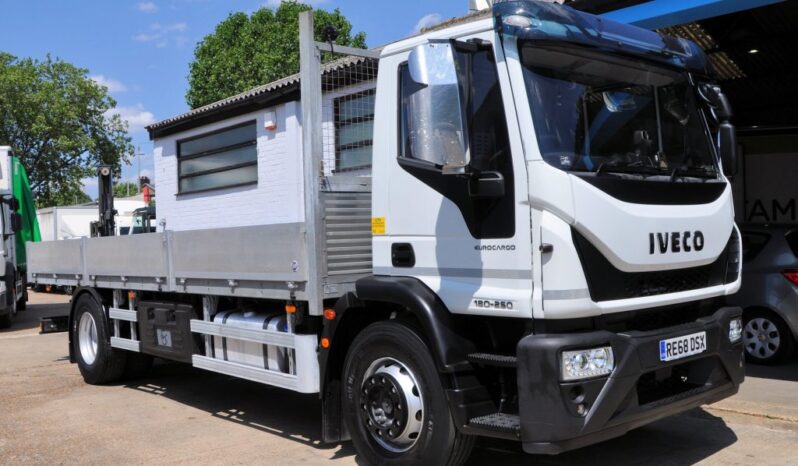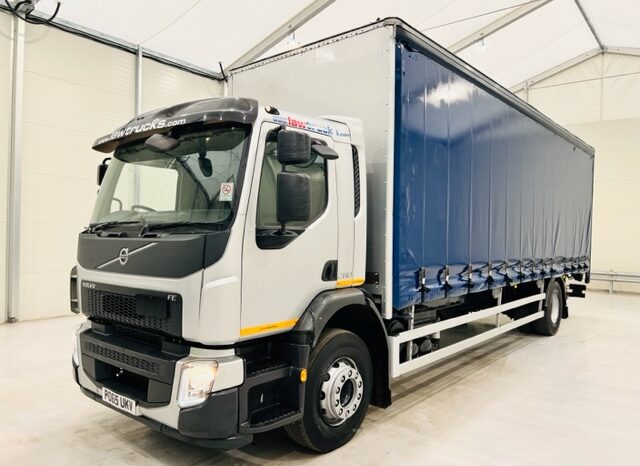The good news is that there is no such thing as a bad 18 tonne truck these days. This means that the chances of you buying a howler are reduced. That’s not to say that all 18 tonners are equal.
What is an 18 Tonner?
Let’s start with the basics. An 18 tonne truck does not mean that it can carry 18 tonnes, this weight denomination is the truck’s Gross Vehicle Weight (G.V.W.) which is the maximum permissible legal weight for the truck, body driver, load, fuel combined. When fitted with a simple flat or curtainside body, an 18 tonner will weigh in around 8 tonnes unladen. This means that they can carry in the region of 10 tonnes. If the truck is fitted with tail lifts, refrigerated units or cranes, the truck will weigh more and the payload available will be reduced by this weight.
Also bear in mind that if the truck has a particularly long wheelbase/body – wheelbases can go up to 7 metres on an 18 tonner – or it is fitted with the larges cab available then these factors will also impact the truck’s carrying capacity.
Remember that you will need an HGV licence to drive an 18 tonne truck in the UK. The large goods vehicle licence is shown as category C2 on your driving licence. You will need to be at least 18 if you are going to get a driving job and you will need an initial driver cpc theory and practical. If you want the truck for social and domestic reasons, the minimum age is 21yrs and no driver cpc is required.
Two Axles – 4×2 Configuration
When considering the carrying capacity of an 18 tonner you need to consider the maximum weights permissible per axle – this is particularly important with a front mounted crane which is near the front axle that already bears the weight of the engine and cab.
A typical 18 tonne truck will have just two axles – a 10 tonne rear (drive) axle fitted with twin wheels and tyres on each side and an 8-tonne front (steer) axle with single wheels and tyres. For operations that will tend to overload the front axle (as in the crane example mentioned) it is possible to specify a 9-tonne front axle. This doesn’t mean that it is now a 19-tonner, but you can have 9 tonnes on each axle.
Typical Uses of an 18 Tonner
Distribution
This size of truck is perfectly suited to regional distribution operations. The size of the trucks and their manoeuvrability mean that they are seen delivering to smaller supermarkets and other retail outlets. This is why the most common body type found in the used truck market at 18 tonnes are as box, fridge and curtainsider trucks.
Skip loader Trucks
These vehicles need to be able to carry as much as possible, yet gain access to the smallest of delivery locations. This means with just two axles, they are more manoeuvrable than a three-axle alternative at 26 tonnes. The vast majority of skip lorries on the roads are 18 tonne examples.
Crane Trucks
It is the ease of accessing delivery locations that make the 18 tonner a popular choice as a crane truck. These are typically used in builders merchant type operations where the delivery locations are often residential roads which can be difficult to access for larger trucks.
Municipal Trucks
The weight carrying capacity and ease of operation make the 18 tonner a favourite for local councils. These may have vacuum tanks to clear out blocked pipes or configured as gritters with snow ploughs and demountable bodies.
What are 18 Tonners not Used for?
Not seen as much being used as tippers or refuse trucks, as the payload benefits of a 26 tonne and 32 tonne tipper (that can be driven on the same licence) outweigh any manoeuvrability benefits of an 18 tonner.
All straightforward? Now we know the type of truck we are looking at which manufacturer makes the best one?
All Makes & Models of 18-Tonne Truck
Let’s look at availability of used examples – in other words what makes and models are most commonplace in the market. This will not only give us an indication of what was popular when new, but, thanks to supply and demand, if there are more of a certain type of truck, the chances are better of getting a good deal.
DAF Trucks
In the UK market, you will usually see DAF at the top of the market share list. In the 18-tonne category, this is no exception. They have two models to choose from, the LF and larger cabbed CF (note that there is a CF replacement from 2023 the XD) of the two, the smaller LF is the most popular, as it gives the operator an improved payload. They both use the same PX-7 PACCAR engines, but the LF version is about 500kg lighter than the CF. If you need the truck for local deliveries, then the LF would be our DAF of choice. For power hungry applications such as a skip loader, then the 250/260HP or the 280/290HP would be ideal, but for general distribution work, opt for the LF220 or newer LF230.
Mercedes Trucks
Mercedes have a few models to choose from in this category, depending on the age of the truck you are looking for and whether you need some off-road ability as well. Rewind to before 2014 and the 18 tonne option from Mercedes was the Axor – this shared the small cab with the Atego but was for 18-tonne operation. Many sellers advertise their Axor 18 tonners as Ategos – even though the Axor logo is clearly visible on the truck. The Atego range only goes up to 16 tonnes GVW. The Axor model was discontinued at Euro 6 in 2014 and replaced by the short lived Antos model. This in turn was replaced in 2021 by the Actros model – albeit the cab remained the same as the Antos. Simply put, you can now specify a wide Actros cab and a 2.3 metre narrow Actros (Antos) cab. Since 2014, the construction version of the 18 tonner has been branded the Axor.
Iveco Trucks
It is in the 18 tonne category that Iveco really punches above its weight in the UK market. With more examples running around and typically available for sale than Volvo and Scania combined. The choice of models is simple with Iveco, whilst it is feasible to order a Stralis 18-tonner, effectively only Eurocargo models are available at 18 tonnes in the UK’s used truck market.
Volvo Trucks
Operators of 18 tonne Volvo trucks have the choice between the FL or larger FE models. The keen eyed amongst you will notice that the FL cab looks similar to the DAF LF and Renault Range D. That’s because they are the same cabs all made by Renault Trucks, (Renault Trucks is owned by the Volvo Group). As with the LF/CF examples, Volvo’s 2.1-metre-wide cab FL are suited to local, high payload operations, whereas the larger, 2.3 metre wide FE will find itself on longer distance distribution operations.
Scania Trucks
Scania has the P Series and the G Series available at 18 tonnes, however it is the P Series that we see dominating the 18 tonne segment. The company also makes a low entry version for urban operation (L Series) that is also available at 18 tonnes GVW. You will find some G Series 4×2 18 tonners but with powerful engines and drawbar couplings so they can operate up to 40 tonnes in combination with a drawbar trailer. Whilst these trucks are strictly ’18-tonners’ they are not designed for operation at this weight in the same way that a 6×2 tractor unit has a GVW of just 26 tonnes, but 44 tonnes when coupled to a triaxle semi-trailer.
MAN Trucks
A relatively rare truck in the UK market – you can typically find up to 10 times more DAF 18 tonners than MAN versions in the used market – just search here at Truckpages to check. Your model of choice is restricted to the TGM for 18 tonne operation. The cab is 2.2 metres wide so sites between those manufacturers who have a range of two cabs at this weight. Is this approach the best of both worlds or a compromise?
Renault Trucks
Choose between the aptly named Range D and Range D Wide – does just what it says on the tin. The familiar choice of 2.1 or 2.3 metre cabs for the 18 tonne versions and a choice of 250 or 280HP variants with 6 or 9 speed auto or manual transmissions. The numbers of Renault trucks available at this weight range is limited in the UK’s used truck market.
The Best 18 Tonne Truck for UK Operation
We have to split this in two – the best for high payload, local distribution and for longer distance regional distribution.
- Winner 18 Tonne Truck for Local Operation – Iveco Eurocargo 180E25

- Winner 18 Tonne Truck for Regional Operation – Volvo FE280

